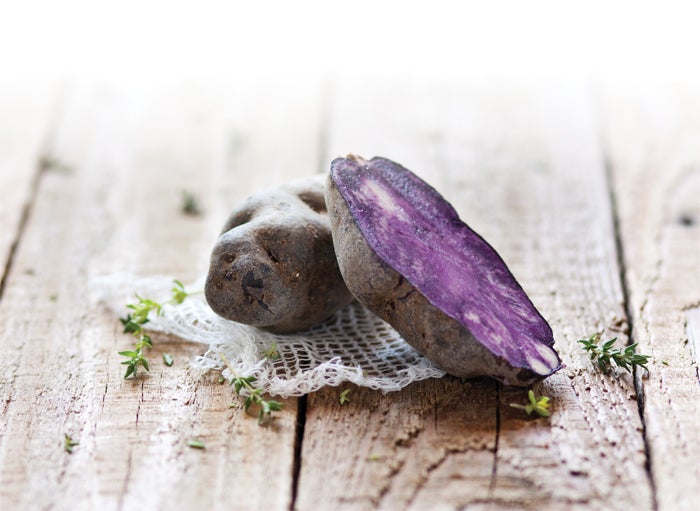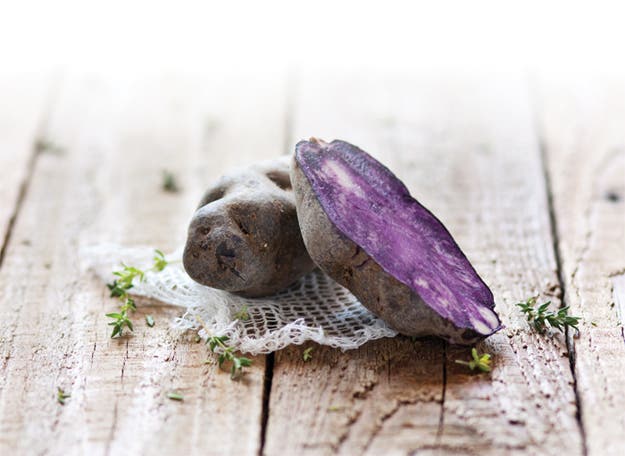9 Fit Foods You Need To Try Now

Open purple potato
Purple Potato

Why it’s super: Anthocyanins, the flavonoids that give these potatoes their distinctive purplish-blue color, have powerful anti-cancer and heart-protective benefits. They’ve also been shown to stimulate your immune system and protect against age-related memory loss.
Why you should try it: Purple potatoes provide solid carbohydrates to fuel your workouts, and because of their anthocyanins, stimulate the immune system when it’s under stress, including during high-performance activity.
How it tastes: Nutty, earthy, slightly bitter
How to use it:
• Dice potatoes and add them to soups, stews and grain salads.
• Mash or purée for a side dish.
• Bake as you would a white potato.
Matcha

Why it’s super: “Matcha is to green tea what Spinning is to the stationary bike,” says Lauren Slayton, MS, RD, author of The Little Book of Thin (Perigee, 2013). This fine powdered tea contains vitamin C, zinc and a host of phytochemicals, which have been linked to the prevention of numerous chronic conditions like cancer and heart disease.
Why you should try it: Matcha gives you a metabolism boost, increases alertness without giving you the jitters and makes a great post-recovery drink.
How it tastes: Earthy, slightly sweet, less bitter than bagged green tea
How to use it:
• Add to smoothies.
• Whisk into hot water or steamed almond
• Throw into pancake or muffin batter.
Mulberry

Why it’s super: Mulberries actually contain 3 grams of protein per ounce, which is unusual in a fruit. They’re also a good source of potassium and magnesium as well as fiber, weighing in at 4 grams per ounce.
Why you should try it: With its protein and fiber content, mulberries are the perfect snack, satisfying you while helping control blood sugar. “Studies have also shown that mulberries increase fat loss when you’re losing weight,” Slayton says.
How it tastes: Raisin-like
How to use it:
• Add dried berries to trail mix.
• Use in salads, cereals or baked goods in place of raisins.
• Use as a topping for oatmeal.
Kefir

Why it���s super: This fermented dairy product contains more than five times the probiotics as yogurt. “Probiotics are important for gastrointestinal functioning and mood, and new research reveals they could also affect weight and sugar cravings,” Slayton says. Kefir is a good source of phosphorus and calcium — a bonus for your bones.
Why you should try it: Kefir is perfect for boosting your immune system, which complements that boost you’re already giving your body in the gym. It also helps you quell sweet cravings. “Kefir, like plain yogurt, has a slightly sour taste, and adding more sour or bitter foods to your diet is one strategy to counter sweet cravings,” Slayton says.
How it tastes: Tangy, tart
How to use it:
• Eat it straight up as you would yogurt.
• Blend it into a smoothie.
• Use it in a parfait.
Maca

Why it’s super: “This tuber boasts the perfect balance of amino acids, unsaturated fats and minerals, and it’s prized for its ability to increase energy levels, endurance and libido,” says Manuel Villacorta MS, RD,. author of Peruvian Power Foods (HCI Books, 2013). Maca contains a ton of antioxidants and is a good source of iron and vitamin C. It also supports hormonal balance, bone health and the immune system.
Why you should try it: Because maca is a natural, sugar-free source of energy, it won’t add excess calories to your diet or cause the blood sugar fluctuations that you would have with an energy bar or sports drink. It will also increase your strength and energy, and improve your performance in the gym.
How it tastes: Bitter, which is why it’s best paired with foods like cacao, bananas or cinnamon to mask the flavor.
How to use it:
• Add to your pre-exercise shake.
• Pour a scoop into baked goods.
• Sprinkle over hot cereal.
Sacha Inchi Seeds and Oil

Why it’s super: Also called Inca-peanuts, the seeds of the Inchi plant are an incredible source of omega-3 and omega-6 fatty acids, as well as vitamins A, E and iodine. Eating them can restore your lipid balance, encourage the production of HDL cholesterol, and help fight heart disease and diabetes.
Why you should try it: “When you exercise, your body endures stress, which causes inflammation,” Villacorta says. The fatty acids in the seeds and oil act as anti-inflammatories. Plus, the seeds are loaded with protein — 9 grams per ounce — and tryptophan, which is a precursor of mood-boosting serotonin.
How it tastes: Nutty, like peanuts
How to use it:
• Eat whole seeds as you would other nuts, raw or dry-roasted.
• Use the oil in place of olive oil in salad dressings.
• Toss the seeds in a salad.
Dandelion Greens

Why it’s super: You might have regarded these as a weed in your garden, but this green leafy vegetable is now a known superfood. It’s rich in calcium (103 milligrams per cup), iron (1.7 milligrams per cup) and fiber (1.9 grams per cup). It’s also high in vitamins A, C and K.
Why you should try it: Because they’re a diuretic, dandelion greens are one of the most powerful weapons against bloat, Slayton says. They’re also great for heartburn and sour stomach.
How it tastes: Slightly bitter, like arugula
How to use it:
• Eat in salads.
• Use in a green juice.
• Steep dried leaves as a tea.
Pichuberry

Why it’s super: This small, orange fruit supplies 39 percent of your daily vitamin D and is a great source of withanolides, which have been linked to the inhibition of cancer cell growth and the prevention of inflammation in the body. It has also been associated with liver fortification, lung health, improved fertility and proper food absorption.
Why you should try it: Its low-glycemic index makes this berry a good low-sugar alternative to other fruits and sweet items. Plus, pichuberries are perfect if you’re trying to lose weight because they give you more volume for fewer calories.
How it tastes: Tart but sweet (like a cross between kiwi fruit and cherry tomatoes)
How to use it:
• Pair it with quinoa in a salad.
• Eat it topped with dark chocolate.
• Slice overtop of oatmeal.
Kiwicha

Why it’s super: Better-known as amaranth, this food is high in protein and has a more complete profile of amino acids than most other grains. It’s also rich in iron, manganese, magnesium, phosphorus and copper, all of which are essential for healthy physical function. Adding kiwicha to your diet may help decrease cholesterol, stimulate your immune system and keep your heart healthy.
Why you should try it: The minerals in kiwicha help facilitate metabolic reactions in the body that relate to muscle movement and the generation of energy, according to Villacorta. Plus, because kiwicha is a seed, it’s digested slowly, reducing spikes in blood sugar, which can affect energy.
How it tastes: Nutty, like quinoa
How to use it:
• Boil or steam as you would quinoa or rice.
• Pop it like popcorn and use in place of puffed rice.
• Use as a gluten-free, healthy breading for meats and meat alternatives.